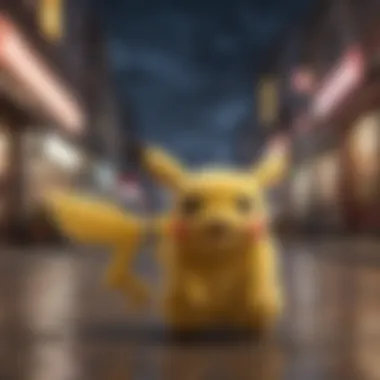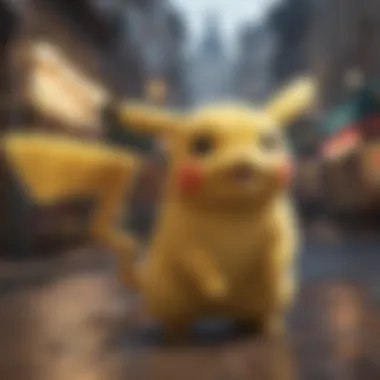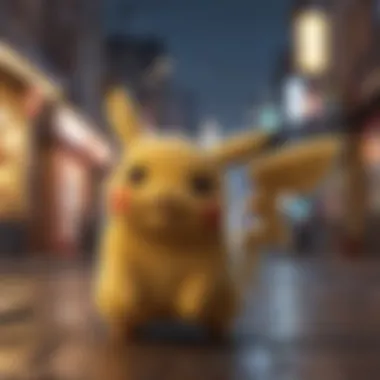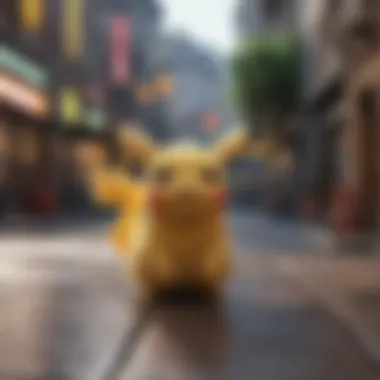Unraveling the Importance of the Pikachu Illustrator Card


Intro
In the world of Pokémon, few items can command the same reverence as the Pikachu Illustrator card. For many collectors and fans, this card is not just another piece of cardboard; it's a slice of history that interlaces the realms of art, culture, and monetary value. Produced for a special drawing competition in 1998, it holds its own against the gold standard of collectibles. It’s rare, it's unique, and its narrative captures the imagination.
This article seeks to weave together the various threads surrounding this iconic card, emphasizing its distinction among other cards in the trading card universe. Unlike more common cards that can be found in abundance, the Pikachu Illustrator card shines with its own luster, steeped in artistic intrigue and cultural significance. The goal is to present an insightful overview that appeals to both seasoned collectors and casual fans alike, exploring why this card has earned its revered status.
The Origins of the Pikachu Illustrator Card
The birth of the Pikachu Illustrator card is an extraordinary tale, rooted in a contest held by CoroCoro magazine in Japan. In 1998, young artists submitted their interpretations of Pikachu, hoping to win a chance to see their work gracing this very card. The results were not just about winning; many entries celebrated creativity and passion for Pokémon.
This particular card was awarded to only a select few winners—around 39 copies are believed to exist today, making its presence in the market incredibly rare.
Artistic Merit and Design
What truly sets the Pikachu Illustrator card apart is its artwork. The card features Pikachu, drawn in a playful and endearing style by artist Atsuko Nishida.
Unlike standard Pokémon cards, which often showcase battle-focused imagery, the Illustrator card presents Pikachu in various artistic poses, exuding a whimsical charm that captures the essence of the character. It’s an art piece as much as it is a trading card, earning admiration not just from collectors, but from art enthusiasts.
This card invites players and collectors to consider Pokémon as a form of art—highlighting not just the characters, but the creativity behind them.
Cultural Impact
In a broader context, the Pikachu Illustrator card intersects with the culture it emerged from. Pokémon has been more than just a game; it’s a cultural phenomenon that has influenced generations. The availability of this card has put it on a pedestal, making it not only a collectible but also a ‘holy grail’ for many.
Collecting this card has become a rite of passage for some Pokémon enthusiasts, signifying their dedication to the franchise. The card has transformed into a touchstone of nostalgia, representing childhood memories interlaced with Pokémon adventures.
"For many, the Pikachu Illustrator card stands as a testament to the fusion of art and fandom, serving as a bridge between childhood dreams and adult aspirations."
Financial Allure
As the years rolled on, the Pikachu Illustrator card has equally gained a reputation for its monetary value. In 2021, one such card sold for over $5 million, breaking all records for trading cards. The significant price tag draws attention, not just for collectors, but investors looking to tap into the lucrative world of collectibles.
The allure of this card is amplified by its scarcity and unique backstory, leading to discussions about its value proposition—does owning such a card denote a solid investment or is it merely a luxury good?
Either way, the Pikachu Illustrator card remains a fascinating topic within both collectible and financial circles.
The End
The Pikachu Illustrator card embodies more than just a collectible; it tells a story of artistic expression, cultural significance, and financial curiosity. Its unique background and artistic merit create a compelling narrative that has captured the hearts of many. Whether viewed through the lens of a collector, an investor, or an admirer of art, there’s no denying the card’s momentous impact in various realms.
Intro to Pokémon Trading Cards
The realm of Pokémon trading cards is not just a game; it’s an intricate tapestry woven from nostalgia, strategy, and artistry. These cards have evolved from simple collectibles into cherished items full of personal value and significant monetary worth. In this article, we will explore how trading cards are not merely pieces of cardboard but cultural artifacts that carry a legacy.
The Evolution of Trading Cards
From the moment the Pokémon franchise took the world by storm in the late 1990s, trading cards have seen a tremendous transformation. Initially, collectors focused on rare cards, but soon the market expanded to include a wide variety of editions, featuring different Pokémon, artwork, and rarity levels. Collector’s editions began to emerge, making certain cards more sought-after than others.
In the beginning, it was simple. You had your basic characters like Pikachu, Charmander, and Squirtle. Now? There are special cards that commemorate milestones or events – like the Pikachu Illustrator card itself, which epitomizes the uniqueness of collectible cards. It’s as if each card tells a story, from the palm of your hand to the shelf it adorns.
Moreover, technology’s role in this evolution cannot be overlooked. The rise of online trading platforms has made acquiring and trading cards easier than ever. Card values can fluctuate dramatically based on demand, condition, and even the whims of the market.
Cultural Impact of Pokémon
The cultural footprint of Pokémon is massive and far-reaching. Pokémon has transcended entertainment into a lifestyle for many. Kids who once ran home from school to watch the anime have grown into adults who reminisce about their childhood as they collect cards.
The influence of Pokémon can be likened to a wildfire, spreading enthusiasm across generations. The return of trading card games also reintroduced concepts of strategy, competition, and camaraderie among players. Additionally, events like Pokémon tournaments regularly bring people together, fostering community, connection, and friendly rivalry.
Here’s why Pokémon isn’t just a game:


- Nostalgia: Grew up with it? You’re likely to hold onto that feeling.
- Community: The gatherings and tournaments unite fans from all walks of life.
- Collectability: The hunt for rare cards stokes the flames of enthusiasm, adding depth to the experience.
As you delve into the specifics of the Pikachu Illustrator card, understanding this cultural context elevates its significance. It’s more than just a card; it’s a piece of history that ties together the evolving landscape of Pokémon trading cards with the passions of countless fans.
Understanding the Pikachu Illustrator Card
The Pikachu Illustrator card stands as an illustrious hallmark in the realm of Pokémon trading cards. It's not merely a piece of cardboard with some dazzling images; it symbolizes the intersection of art, passion, and collectability that has spun a myriad of stories since its inception. To truly grasp its significance, it’s essential to look into several dimensions: the story behind its creation, the design elements that make it outstanding, and its scarcity that elevates its status. Within this section, we’ll peel back the layers of the Pikachu Illustrator card, revealing the multiple facets that contribute to its cherished place in collectors’ hearts.
Origins and Design
The origins of the Pikachu Illustrator card are tied intricately to a unique Pokémon event held in Japan during 1998. It was an art contest that showcased the talent of young Pokémon fans, essentially merging creativity with the Pokémon brand. The winners received this card not just as a trophy, but as an embodiment of their artistic ability and the spirit of the Pokémon community.
The design of the card itself is captivating. A cheerful Pikachu grabs attention as it strikes a playful pose, surrounded by vibrant colors and whimsical elements. Each stroke resonates with joy and a sense of adventure, mirroring the essence of the Pokémon universe. Furthermore, the artist's flair is evident, giving it a handmade charm rather than a corporate polish. This design is significant as it serves not merely as a collectible card, but as a canvas reflecting the creativity and enthusiasm of Pokémon fans.
Creator: Aikon Shoji
At the helm of this creation is the talented Aikon Shoji, an artist whose imagination brought Pikachu to life on this card. Shoji’s background in art allows for a unique interpretation of Pokémon, breathing individuality into the franchise. His role in the Pokémon art scene is noteworthy. Unlike the more mainstream card art, Shoji’s piece stands apart, resonating with those who appreciate a more personal touch. It’s an artful dialogue between the character and its surroundings, an intimacy that few other cards convey. The fact that a single artist can shape a community's perception of an iconic character like Pikachu speaks volumes about the impact of individual creativity within larger pop culture.
Limited Edition: How Many Exist?
When it comes to the Pikachu Illustrator card, rarity plays a pivotal role in its allure. While countless Pokémon cards circulate in markets worldwide, only 39 copies of the Pikachu Illustrator card were originally awarded. This limited distribution marks it as one of the rarest cards to ever grace the Pokémon trading card game, cementing its position as a coveted trophy for collectors.
Its scarcity has led to a frenzy among collectors, with prices skyrocketing to astronomical figures during auctions. To comprehend the depths of its rarity, it’s helpful to consider that many common cards are accessible to anyone with a few dollars. In contrast, the Pikachu Illustrator card sits in a different league entirely, like a pearl in an ocean of stones. The card's valuation fluctuates with market trends, but its limited existence makes it a perennial favorite among serious collectors.
"In a world flooded with collectibles, the Pikachu Illustrator card shines not just because of its artistry but because of its scarcity—an elusive gem that represents the pinnacle of Pokémon collecting."
As we navigate through the artistic allure, the origins, and the limited nature of the Pikachu Illustrator card, it becomes clear that these factors meld together to form a remarkable narrative, making it far more than just another card. With each subsequent section, we will further unravel its historical context and explore its profound impact on the Pokémon trading card community.
Artistry and Aesthetics
The significance of artistry and aesthetics in the Pikachu Illustrator card cannot be overstated. This particular card serves not just as a collectible, but as a piece of art, rich in colors and characters that resonate with fans and collectors alike. The way this artwork is crafted offers a glimpse into the fusion of creativity and commercialism, allowing players and enthusiasts to appreciate the deeper emotional connection fostered through visual representation. The aesthetics of Pokémon cards transcends mere visuals; it speaks to the values and memories of an entire generation.
Artwork Analysis
At first glance, one can appreciate the vibrant colors and unique design that the Pikachu Illustrator card showcases. The illustration is not just about Pikachu, but it's the whole composition that draws in observers. The character is depicted in a playful pose, exuding an aura of joy and adventure. The background complements this with whimsical elements that evoke a sense of nostalgia for those familiar with the franchise. It’s not just a character; it’s a celebration of the Pokémon spirit.
Moreover, the card's artistry reflects a broader cultural context. Created by illustrator Atsuko Nishida, the artwork encapsulates the heart of what Pokemon represents. Viewing it becomes a multifaceted experience—one that blends the joy of childhood, community bonding, and an individual’s passion for collecting. People often say that "a picture is worth a thousand words," and in this case, that rings true. The choice of colors, the composition, and even the font used for 'Illustrator' create a lasting impression that is both inviting and evocative.
Comparison to Other Cards
When putting the Pikachu Illustrator card against other Pokémon cards, it becomes evident why it's held in such high regard. While many cards flaunt popular characters with various moves and abilities, this card stands apart as it combines an artistic vision with rarity. Unlike cards released in bulk, the Pikachu Illustrator was awarded to only a handful of winners in a drawing competition, genuinely elevating its status.
In comparison to other artworks, like the holographic Charizard, which is often praised for its dynamic imagery, the Pikachu Illustrator card emphasizes a different kind of artistry—one rooted in childlike wonder and joy. While both cards are adored, the Illustrator card’s backstory and the emotional connection with its design give it a unique touch that others lack.
- Artistry and rarity: This card’s distinctive aesthetic appeal captures not only the character but also the essence of the Pokémon journey.
- Size and format: Its smaller size compared to many modern cards also contributes to its vintage charm.
- See the differences: By examining these artistic nuances, collectors understand that this isn’t just about having a Pikachu card—it’s about possessing a slice of Pokémon history.
Ultimately, the artistry and aesthetics of the Pikachu Illustrator card highlight its important role within the Pokémon universe, bridging connections between collectors, players, and casual admirers. This card isn’t just a collector’s item; it's a piece of art that tells a story, resonating through layers of creativity and nostalgia.


Historical Context
Understanding the historical context of the Pikachu Illustrator card is vital for grasping its significance within the broader narrative of Pokémon trading cards. This card not only embodies a unique artistic vision but also represents a milestone in the evolution of trading cards themselves.
Release of the Pikachu Illustrator Card
The Pikachu Illustrator card was released in 1998, a time when Pokémon was rapidly gaining traction around the globe. However, this card was no ordinary promotional item. It was awarded to winners of an illustration contest held by CoroCoro Comic, deepening its exclusivity. Unlike most trading cards, which were widely available through packs, the Pikachu Illustrator card was limited to a mere handful of copies.
This exclusivity means the card has become a symbol of prestige in collecting circles. One of the underlying factors that fueled interest in this card was its backstory; it wasn't just a card, but a trophy of artistic recognition. Therefore, when collectors eyed its release, they didn't merely see a card, but a slice of Pokémon history that few could attain. This limited distribution set the stage for the card's soaring value in subsequent years.
Significance in the Early Pokémon Community
The early Pokémon community was rife with passion, driven by a shared love for the franchise. The Pikachu Illustrator card played a crucial role in solidifying the community's values and aspirations towards collecting. It wasn’t just about having cards; it was about having unique pieces that told stories. Proud owners of the card were often hailed among their peers, creating a hierarchy among collectors.
The significance of the Pikachu Illustrator extended beyond mere collectability. It represented a creative achievement within the community, where fans were encouraged to express their artistic abilities. This sense of encouragement can still be felt in various Pokémon fan art and conventions today, as many artists look back and draw inspiration from the original contest.
The Pikachu Illustrator card, in this sense, became more than just a collectible; it was a catalyst for community formation. It fostered friendships and fostered a sense of belonging as fans gathered to discuss strategies and showcase their prized possessions.
"The real joy of collecting comes not just from ownership, but from being part of something bigger, something that lasts."
Overall, the card influenced the dynamics of the Pokémon trading card game by making collectors invest more than just money—they invested emotions and aspirations as well.
Understanding these historical layers helps illuminate why the Pikachu Illustrator card is cherished both as a collectible and a cultural artifact.
Market Value and Collectability
The market value of collectibles often reflects not just their physical attributes but the emotions and memories they evoke. In the realm of the Pikachu Illustrator card, the steep price tags attached to it make a compelling case for the intersections of nostalgia, rarity, and cultural significance. Collectors don’t just pursue this piece of cardboard; they chase the stories and memories tied to it.
Understanding the nuances of market value and collectability is essential when discussing the Pikachu Illustrator card. This card is not merely a game piece; it's a symbol of a culture that resonates deeply with fans who grew up battling and trading Pokémon. The card’s limited availability and unique artistic history craft an important narrative around what makes it valuable in both emotional and financial contexts.
Current Market Trends
The current market trends for the Pikachu Illustrator card demonstrate how fluctuations in demand can dramatically influence prices. Recently, the card has seen a resurgence in interest, completing a dance with collectors that ties back to the nostalgia for the Pokémon series that many millennials and Gen Z individuals cherish.
- Rarity and Demand: As the Pokémon trading card market evolves, so does the demand for rare cards. With other cards emerging and the community breathing new life into collecting, the Pikachu Illustrator card stands tall as one of the benchmarks for desirability.
- Auction Highlights: Recent auction houses have witnessed multiple instances of this card fetching heights that could send anyone in shock. Auction records from sites like eBay show prices reaching upwards of hundreds of thousands of dollars, reflecting both collectors' fervor and the growing investment trends in high-value collectibles.
- Market Fluctuations: Prices may ebb and flow due to broader economic factors and the Pokémon brand itself. Economic downturns, for instance, can cool buyer enthusiasm, while booming interest can lead to frenzied bidding wars.
In hindsight, it's crucial to keep an eye on the shifting sands of the market. Prices can soar or plummet based on not just the card's rarity but the cultural touchpoints associated with it, making active monitoring a must for serious collectors.
Notable Sales and Auctions
The Pikachu Illustrator card has witnessed some jaw-dropping sales that serve to underline its value in the collector's market. Here are a few notable examples that stand out:
- 2020 Auction Experience: In a widely publicized auction in early 2020, one Pikachu Illustrator card sold for a staggering $233,000. The winning bidder highlighted the emotional connection they had with the series, stemming from childhood experiences.
- The Last Sold Card: More recently, another copy exchanged hands at an auction for just over $375,000. This record-breaking sale not only made waves across the collector community but also pulled a spotlight onto the intricate world of Pokémon trading cards.
- Influence of Social Media: Platforms like Reddit have also played a significant role in showcasing sales and auction results. Enthusiasts share their findings, creating a sense of camaraderie and knowledge that enriches the community experience.
The combination of rarity, historical significance, and emotional resonance makes the Pikachu Illustrator card an integral part of the Pokémon collectible psyche. Each sale reaffirms the card's prestige, and collectors keen to own a piece of this legacy may find themselves riding the waves of this artistic endeavor.
The Psychology of Collecting


Collecting is not just a hobby; it is a tapestry woven from passion, nostalgia, and also a dash of competition. Especially in the realm of Pokémon, the act of collecting transcends the mere acquisition of trading cards. It delves into deeper emotional territories, often linked to varied psychological triggers. Understanding the psychology behind collecting the Pikachu Illustrator card helps in grasping the broader implications of what it represents for enthusiasts and collectors alike.
Motivations Behind Collecting
When we discuss motivations behind collecting something as iconic as the Pikachu Illustrator card, a few key points surface. Many collectors harbor a passion for the Pokémon universe, viewing themselves as custodians of its history. The celebratory essence of Pokémon is found in its uniqueness and rarity, stirring an almost primal urge in collectors to own a piece of this cherished lore. One primary motivation includes:
- Identity and Status: Collecting rare cards can confer a sense of identity among peers. Owning a Pikachu Illustrator card is often more than just having a collectible; it’s about holding a status symbol within the community.
- Competitive Element: Just as in any hobby, competition exists. Individuals may seek rare cards not only for personal satisfaction but also to rank higher amongst collectors, often highlighting their prowess in the trading card scene.
- Investment Potential: For some, it's a calculated financial venture. With the market value of the Pikachu Illustrator card soaring, collectors view their acquisitions as investments, blending passion with monetary interest.
The Role of Nostalgia
Nostalgia plays a significant role in the collecting psyche. Many fans who grew up during the height of Pokémon's popularity look back fondly at their childhood experiences. The Pikachu Illustrator card ties back to those simpler, more innocent times. Some points to consider about nostalgia in this context include:
- Emotional Connection: The bonds formed in youth often last a lifetime. The Pikachu Illustrator card can evoke memories of trading cards in the schoolyard or watching Pokémon episodes with friends, feelings that resurface whenever the card is handled or displayed.
- Legacy of a Generation: As many collectors are now adults, the act of collecting represents a continuous link to their childhood dreams. Investing time and money into cards, especially iconic ones, becomes a way of preserving that part of their life.
- Community Engagement: Nostalgia compels individuals to share their love for Pokémon, leading them to participate in community events, forums, or trading sessions. The Pikachu Illustrator card serves as a conversation starter that bridges generational gaps, allowing older fans to connect with newer ones.
"For many collectors, the Pikachu Illustrator card isn't just a card; it's a portal to their past, a story they carry forward into the future."
In summary, the psychology of collecting is woven with complex motivations and emotional ties, where the Pikachu Illustrator card stands at the crossroads of personal history and community belonging. By examining these motivations and the nostalgic sentiments intertwined with the card, we can better appreciate its significance in the Pokémon universe.
Community and Culture
The Pikachu Illustrator card has transcended its status as merely a collectible piece, becoming a cultural emblem within the Pokémon fan community. This section dives into the significance of community engagement surrounding the card, emphasizing how it fosters connections among fans and influences the broader Pokémon fandom.
Fan Engagement with the Card
Engagement with the Pikachu Illustrator card goes beyond mere ownership. Fans around the world celebrate this card not just for its rarity, but as a symbol of creativity and community. Enthusiasts often form groups or participate in forums to discuss the artistic elements of the card and its background. On platforms like Reddit and specialized Facebook groups, collectors swap stories, share their collections, and even organize events centered around this iconic card.
One of the notable aspects of the fan engagement is the celebration of creativity among the Pokémon community. Fans often create fan art inspired by the Pikachu Illustrator card, demonstrating their appreciation for its design and historical value. These artistic expressions can lead to collaborations where various artists participate in themed contests or showcases that honor the original work. These interactions not only solidify bonds within the community but also enhance the card's cultural standing.
Influence on Pokémon Fandom
The Pikachu Illustrator card has had a notable ripple effect throughout the Pokémon fandom. As an avenue for both nostalgia and artistic appreciation, this card serves as a conversation starter among fans from different backgrounds and ages. It symbolizes a shared history and appreciation for the Pokémon franchise.
Moreover, the card has influenced various aspects of Pokémon culture and community initiatives. For example:
- Collecting Culture: The rarity of the Pikachu Illustrator card has inspired many newcomers to venture into card collecting, urging them to learn about the intricacies of the market, grading systems, and online platforms.
- Pokémon Events: Tournaments and conventions often feature the Pikachu Illustrator card in exhibits or panel discussions. This can pique interest in new generations of fans who might not be aware of its historical context.
- Merchandise and Adaptations: The iconic status of the card inspires merchandise ranging from apparel to accessories, allowing fans to wear their appreciation for this piece of history boldly.
"The Pikachu Illustrator card isn’t just collectible; it’s a conversation piece that sparks connections between generations of Pokémon fans."
In summary, the card enriches the Pokémon community by fostering discussions, promoting creativity, and serving as a cultural touchstone for fans of all ages. Through fan engagement and its remarkable influence on the entirety of the Pokémon fandom, the Pikachu Illustrator card continues to stand as a towering monument of creativity and collaboration.
The End
The conclusion of this article importantly encapsulates the intriguing journey through the landscape of the Pikachu Illustrator card. This unique card is not just another piece of cardboard; it embodies an era, a cultural phenomenon, and a testament to artistry. Through examining its historical backdrop, artistic contribution, and current standing in the collectibles market, we see that the Pikachu Illustrator card holds an unparalleled significance in the world of Pokémon trading cards.
The Lasting Legacy of Pikachu Illustrator
The legacy of the Pikachu Illustrator card extends far beyond its physical form. At its core, this card represents a merging of nostalgic childhood memories and modern-day collecting fervor. For many, it’s a symbol of the joy that Pokémon has brought into their lives. Its distinct art style by Aikon Shoji resonates with fans, reminding us of a simpler time when catching Pokémon and trading cards filled our weekends.
Moreover, the limited number of these cards ensures that they remain coveted collectibles. Those fortunate enough to own one have a piece of Pokémon history in their hands, making them modern-day relics. The stories surrounding the card – from how winners of the illustration contest received it to the paths taken by its owners – add layers to its heritage. While its monetary value is noteworthy, the true worth lies in the memories it conjures for collectors.
Future of Pokémon Trading Cards
As the trading card game landscape evolves, the future of Pokémon cards, particularly the Pikachu Illustrator, stands at an exciting crossroads. With innovations in game mechanics and the emergence of digital card platforms, Pokémon is broadening its horizons. These changes could bring a new wave of enthusiasts into the fold, revitalizing interest in older cards while introducing newer options.
In addition to digital formats, we might witness a shift in how people value physical cards. With retro trends becoming fashionable, older cards, including the Pikachu Illustrator, might experience a renaissance in interest. Collectors looking to differentiate themselves will likely seek unique items, preserving these cards' value over time. Furthermore, the community surrounding Pokémon continues to grow, embracing new generations while ensuring the appreciation for classics like the Pikachu Illustrator card remains strong.





